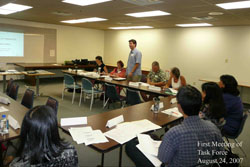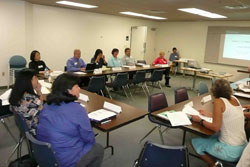Accessibility for All



Project Dates: 2007 – 2010
About
The purpose of the “Accessibility for All” project is to explore the usefulness of the digitized Remote Accessibility Assessment System (RAAS) to people with disabilities in underserved areas. A previous study that applied the RAAS to three houses in the Pittsburgh, PA area confirmed that the System was able to evaluate the accessibility of the target built environment. By applying the System to Hawaiian Islanders with disabilities, this study can demonstrate that the System can be applied in remote and underserved communities. The study can also assist in evaluating the application of the RAAS in the workplace.
The study will recruit three users of a wheeled mobility device (WMD) in Hawaii and assess the problems of accessibility for them in their daily work activities. The study will use two methods for evaluating accessibility in the same work situations: 1) the RAAS (the experimental method), and 2) Conventional In Person (the control method). The study will compare the RAAS results with the Conventional In Person (CIP) results.
The study will use hardware and software to facilitate the RAAS evaluation of built environments. The RAAS method will use a consumer-level digital camera and Photomodeler Pro 5.0 to construct 3D models of the target environment. A web-based decision-supporting system and wheelchair maneuvering simulation system will also be used. If the study demonstrates that the RAAS yields results comparable to the CIP method, digital assessment of homes, government buildings, and work places can be used to design modifications that increase accessibility, saving both time and money for WMD users and property owners alike. The project can also lead to rapid digitization of a real-world environment into a virtual 3-D environment for the purposes of remodeling and testing of current and future layouts. Further, success with this project will also mean accessibility assessment for WMD users in remote and underserved areas across the U.S. and other regions.
Persons who use wheelchairs in the U.S. are estimated to total more than 2.2 million. Persons with disabilities who live in non-metropolitan areas make up a higher proportion (23 percent) of the local population than those who live in metropolitan areas (18 percent). Moreover, fewer services or resources are available to meet the needs of persons with disabilities in non-metropolitan communities. In the State of Hawaii, an estimated approximately 70,000 persons have physical disabilities, and about half of these live in areas outside metropolitan Honolulu and on islands of Hawaii other than Oahu (U.S. Census Bureau, 2000). To this, add the fact that more than 500 islands are spread across the Pacific, and many jurisdictions and territories on these islands have no land access to medical facilities and professional evaluation.
Validation of the RAAS will enable use of the new technologies of web-based decision supporting system and wheelchair maneuvering simulation system to enhance services to persons in real-world situations, and particularly to persons with disabilities in remote communities.
The Center on Disability Studies at the University of Hawaii, a member of a National Network of University Centers, the Association of University Centers on Disability, will provide administrative leadership in disseminating results of this study.
Principal Investigator: Weol Soon Kim-Rupnow


